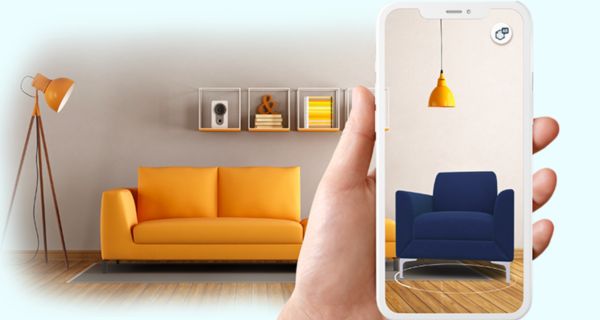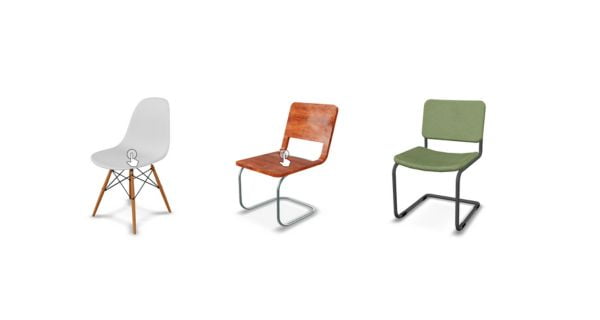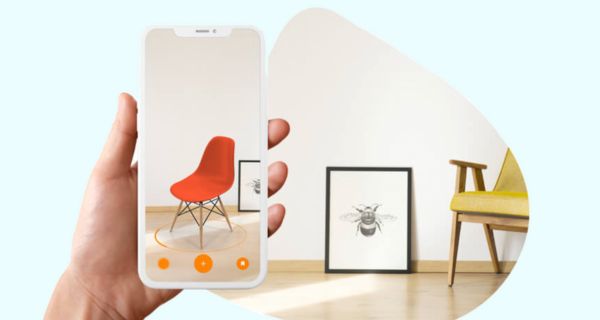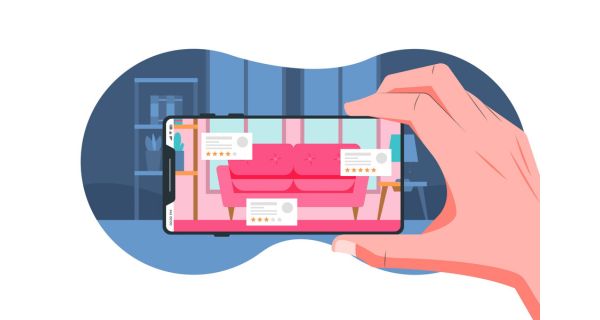Augmented reality has revolutionized how we shop for furniture, making the process more efficient, convenient, and fun. This cutting-edge technology has transformed the traditional brick-and-mortar shopping experience. AR furniture experience enables customers to visualize furniture in their homes before purchasing it without leaving their homes. This has significantly reduced the stress and time required to choose the perfect piece of furniture, allowing customers to make more informed decisions and avoiding costly mistakes.
As Augmented Reality technology continues to evolve, it is clear that it will play an increasingly important role in the future of furniture design and retail. The ability to see and experience furniture in AR has opened up new possibilities for customers and retailers alike, making the process of designing and decorating enjoyable.
What encourages the adoption of AR furniture experience?
Augmented Reality in the furniture industry enables customers to visualize furniture in their homes before purchasing. While the exact numbers may vary, it’s evident that a considerable percentage of consumers are interested in using Augmented Reality to enhance their furniture shopping experience.
Today, 60% of consumers believe Augmented Reality can revolutionize furniture shopping, allowing them to try out different styles and configurations without visiting a store. Only 12% of US home furnishings consumers purchased AR in 2019, potentially due to only 1% of retailers offering AR/VR. However, 77% of shoppers are interested in using AR to see product differences. The pandemic has accelerated the shift to online shopping, and retailers are turning to AR to bridge the gap between online and offline shopping. AR technology can offer an immersive and engaging shopping experience, reducing returns and increasing customer loyalty.
In conclusion, while the adoption rate of Augmented Reality in the furniture industry may currently be low, the potential of this technology is immense. With a significant percentage of consumers expressing interest in using AR for furniture shopping, it’s only a matter of time before this technology becomes a standard feature in online retail.
AR in Furniture Industry

This feature is crucial for big-ticket items such as sofas, beds, and cabinets. It reduces the risk of disappointment with buying something that doesn’t fit the intended space or match the rest of the room’s aesthetics. With Augmented Reality, customers can explore various furniture options and configurations from the comfort of their homes. In addition, they can compare and contrast different styles, colors, and sizes, enabling them to make informed purchasing decisions.
In addition to helping customers find the perfect furniture for their homes, Augmented Reality also fosters stronger connections between brands and customers. Brands integrating AR technology into their online retail platforms demonstrate their commitment to customer satisfaction and innovation. They differentiate themselves from their competitors by offering an immersive and interactive shopping experience and building customer trust.
Overall, Augmented Reality has transformed the economics of online shopping for furniture. It offers customers a personalized and engaging shopping experience, reduces the risk of returns and disappointments, and fosters stronger connections between brands and customers. With AR, the furniture industry is poised to deliver customers a more seamless, enjoyable, and satisfying shopping experience.
AR & 3D web view in furniture shopping

In today’s area, furniture brands have started adopting advanced technologies like Augmented Reality and 3D web viewers to enhance the online shopping experience for their customers. Augmented Reality technology allows consumers to preview furniture in their homes before making a purchase. At the same time, 3D web viewers enable them to view products from all angles in a highly interactive and immersive way.
One furniture brand that has successfully implemented Augmented Reality technology is IKEA. Their AR furniture app for Android & iOS, IKEA Place is so far the best AR furniture app that lets customers virtually place furniture in their homes using their smartphones. You can experience their sofa AR view, place furniture in your space virtually, and move and rotate them in your space. This feature has significantly improved IKEA’s customer engagement metrics, such as increased time spent on their website, higher click-through rates, and lower return rates.
Another brand that has leveraged 3D web viewers is Wayfair. Their 3D model viewer enables customers to see the products in 360 degrees, zoom in for more details, and interact with them in a highly realistic way. As a result, Wayfair has seen a 10% increase in its conversion rates and a 40% decrease in returns.
Moreover, the introduction of WebAR has taken the customer experience to the next level. With WebAR, customers can access AR technology directly from their browsers without needing a separate app. This has led to higher adoption rates, improved user engagement, and increased conversions. For example, Cylindo, a leading 3D product visualization solutions provider, has developed a WebAR solution that allows furniture brands to offer their customers a highly immersive and interactive shopping experience.
3D & AR Product configuration and the furniture market
The world of Ecommerce is evolving, and 3D product configuration technology is taking it to the next level. This technology enables B2B businesses to offer customized products tailored to their client’s unique needs, making them stand out in a highly competitive market.
Furniture customization is one area where 3D and Augmented Reality technologies are being utilized to offer several benefits:
- Customers can now try before they buy, with the help of high-end visuals that enhance physical objects with digital content. This means customers can now see how a new sofa would look in their apartment in real-time, without any risk of paying for something that doesn’t fit.
- It helps customers make informed decisions, closing the high-cost and high-risk purchases gap.
- It increases customer satisfaction, speeds up deal closing, and enables interior architects and designers to create personalized home or office designs quickly.
- It can boost order volume, build shopper confidence at purchase, and reduce costly returns.
Product visualization

Product visualization is creating a visual representation of a product that can help potential customers see the final product’s appearance before making a purchase. The importance of product visualization has grown significantly in recent years, particularly with the rise of e-commerce and the need for online shoppers to see what they are buying.
One of the most effective ways of product visualization is 3D visualization. This technology provides a high-quality and realistic representation of the product, making it easier for customers to understand its features, benefits, and how it would look in real life. In addition, 3D visualization technology offers several benefits, such as the ability to rotate and zoom in and out, allowing customers to view the product from all angles. This feature makes it easier for customers to understand the product’s details and make an informed purchasing decision.
The benefits of product visualization are not limited to customers alone; businesses also benefit significantly. For example, product visualization technology can reduce product returns by giving customers a realistic view of the product before buying it. It also helps businesses to reduce operational costs by streamlining the design and production process. The technology also allows companies to reach a broader audience by showcasing their products online, which customers can access worldwide.
In addition to the ability to visualize furniture in a space, some Augmented Reality furniture apps also allow users to take a photo of their current room and render it into a 3D format. This exciting feature has proven to be a game-changer in the furniture industry, as it enables customers to see how a piece of furniture would look in their actual space before making a purchase.
Conclusion: The future is AR…
The furniture industry has been quick to embrace AR, and many companies, including Amazon and CB2, have developed AR tools to help customers design and decorate their homes. These tools allow customers to place furniture virtually in their rooms and see how it would look before purchasing. Some apps even use advanced computer vision technology to analyze room lighting, colors, and textures to create a realistic 3D rendering of the customer’s space. This enables customers to experiment with different styles, colors, and layouts without moving furniture around, saving time and energy. If you are considering creating a furniture AR experience to integrate into your E-commerce website, marketing content, or any other business application, PlugXR can help you do just that seamlessly. Sign up or book a demo now!

